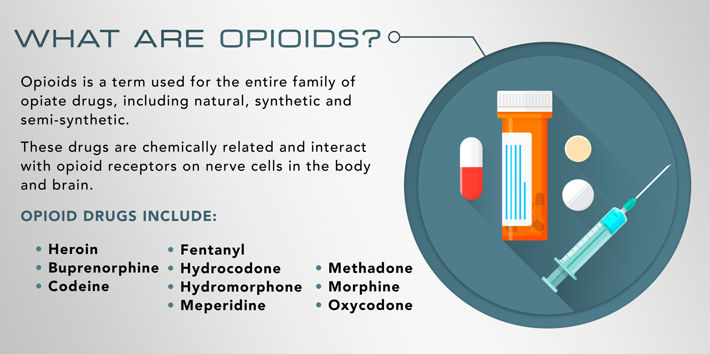OPIOID AWARENESS

WHAT ARE OPIOIDS?
Opioids are powerful psychoactive chemicals that have the ability to effectively relieve serious pain by binding with key receptors in the brain.
PRESCRIPTION OPIOIDS
Opioids may be prescribed to help relieve and control severe or chronic pain. Because prescription opioids can create a sense of euphoria, some people misuse them to get high. If used too much, dependency and addiction can occur and the risk of overdose increases. Commonly misused opioids include: hydrocodone(Vicodin), oxycodone (OxyContin), tramadol and codeine (cough medicine).
FENTANYL
Fentanyl is a synthetic opioid that is 80-100 times stronger than morphine. Pharmaceutical fentanyl was developed for pain management treatment of cancer patients, applied in a patch on the skin. Because of its powerful opioid properties, Fentanyl is also diverted for abuse. Fentanyl is added to heroin to increase its potency, or be disguised as highly potent heroin. Many users believe that they are purchasing heroin and actually don’t know that they are purchasing fentanyl – which often results in overdose deaths. Clandestinely-produced fentanyl is primarily manufactured in Mexico. Fentanyl was developed as a strong prescription painkiller for patients with severe, long-term pain. It is similar to morphine but is 50 to 100 times more potent and extremely dangerous to misuse. Improperly ingesting or touching even a tiny amount can cause overdose or death.
COUNTERFEIT PILLS
More Ventura County drug abusers are overdosing on pills that look like real medications but are often spiked with a lethally potent synthetic opioid according to the Ventura County Pharmaceutical Crimes Unit. Instead of the drug they supposedly contain, the counterfeit pills are commonly laced with fentanyl. “You have to be very, very, very careful,” Young said. “Even just touching it could put a responding law enforcement officer or firefighter at risk.”
According to the DEA, “Capitalizing on the opioid epidemic and prescription drug abuse in the United States, drug trafficking organizations are now sending counterfeit pills made with fentanyl in bulk to the United States for distribution. Counterfeit pills that contain fentanyl and fentanyl-laced heroin are responsible for thousands of opioid-related deaths in the United States each year.” Fentanyl and other highly potent synthetic opioids remain the primary driver behind the ongoing opioid crisis, with fentanyl involved in more deaths than any other illicit drug.
KNOW THE OVERDOSE SIGNS
- Unconscious/unresponsive
- Breathing slowly – or not at all; gurgling sound often heard
- Lips/fingernails blue
UNRESPONSIVE? WHAT TO DO
- Call 911 immediately. “I need help. I’m with someone who isn’t breathing” Provide the street address and location.
- If the person isn’t breathing, do Rescue Breathing.
- Make sure nothing is in the mouth.
- Tilt chin back and pinch nose.
- Give a slow, full breath every 5 seconds for 1 minute.
- Give naloxone. Naloxone needs time to work!
- Continue Rescue Breathing.
- Still unresponsive after 2 minutes? Give the second dose of naloxone using the same method as the first dose.
- Continue Rescue Breathing.
- Once breathing resumes, lay the person on their side in the recovery position, raising their knee to prevent them from rolling over, and place their arm under their head.
- Stay with them. This is important because the person that received naloxone might feel sick, and want to take another dose to feel better. Remind the person it will wear off soon, and doing more drugs could put them back in an overdose situation.
- If you aren’t going to stay on the scene for medical responders to arrive, leave doors unlocked and open.
YOU CAN SAVE A LIFE
LEGAL PROTECTION
Laws are currently in place that support making naloxone more readily available.
CALIFORNIA’S GOOD SAMARITAN LAW
- California Civil Code Section 1714.22 (Statutes of 2013, Chapter 707, Sec. 1) (PDF) eliminates civil and criminal liability for: 1) licensed health care providers that prescribe naloxone and issue standing orders for the distribution of naloxone, and 2) individuals that administer naloxone to someone suspected of experiencing an overdose after receiving it along with required training. This law took effect on January 1, 2014.
STANDING ORDER
- Modeled after San Francisco’s successful program, Ventura County’s Overdose Prevention Program makes use of a standing order written by a physician that allows distribution of naloxone without an identified patient.
- This is similar to what schools do in order to have Epi-pens on hand to address acute allergic reactions.
WHAT IS NALOXONE (NARCAN)?
Naloxone is a safe and legal antidote to reverse opioid overdose. It neutralizes opioids (pain relief medications, heroin, or methadone), reverse fatal side effects, and helps the individual to breath again. The Overdose Prevention Program (NO OD) educates families, friends, and loved ones and focuses on high risk groups. Collecting local data helps guide education, community outreach, and distribution. The "Ventura County Rx Abuse & Heroin Workgroup" brings hands-on training and rescue kits to the Ventura County community.
LEARN MORE